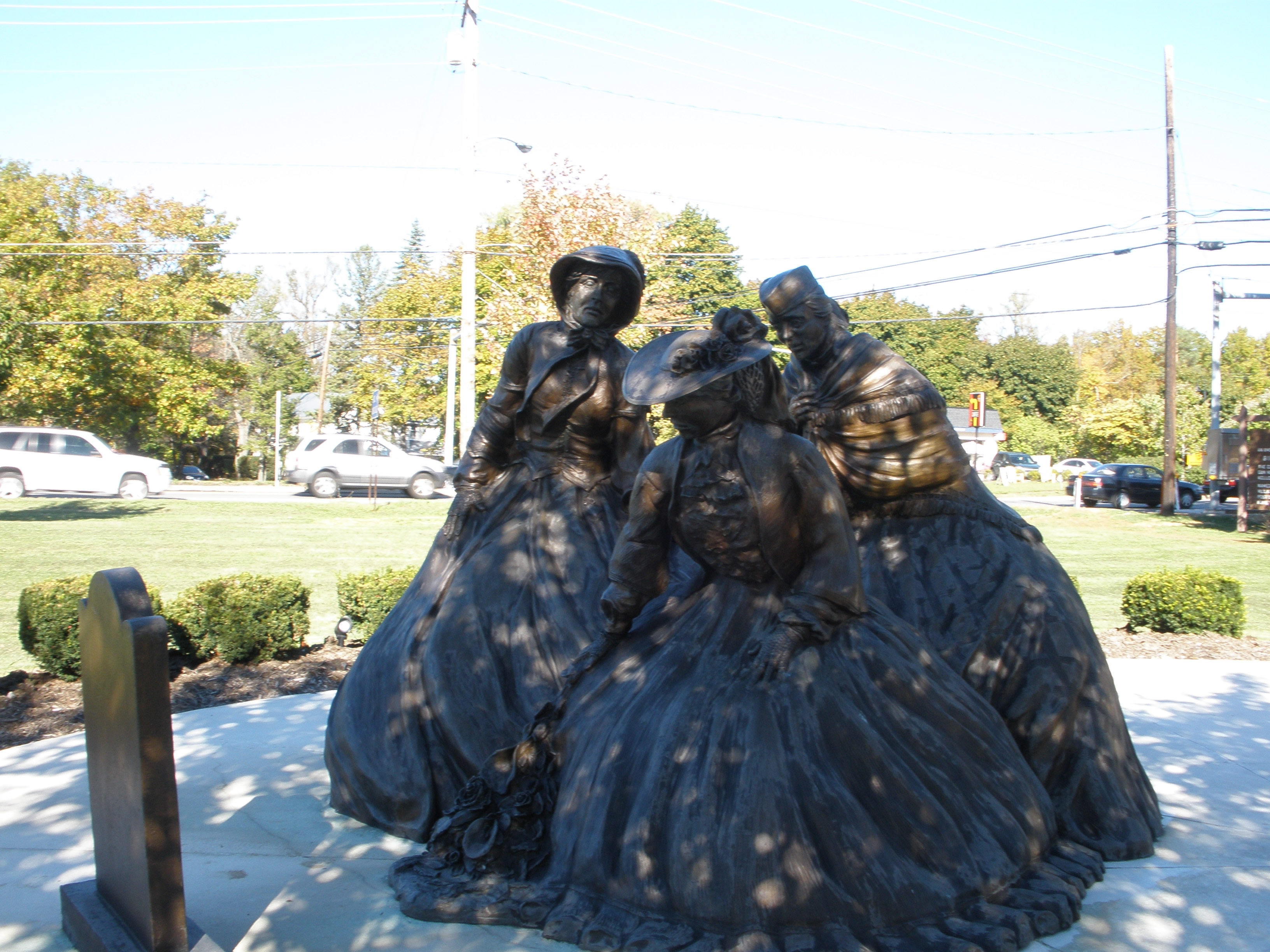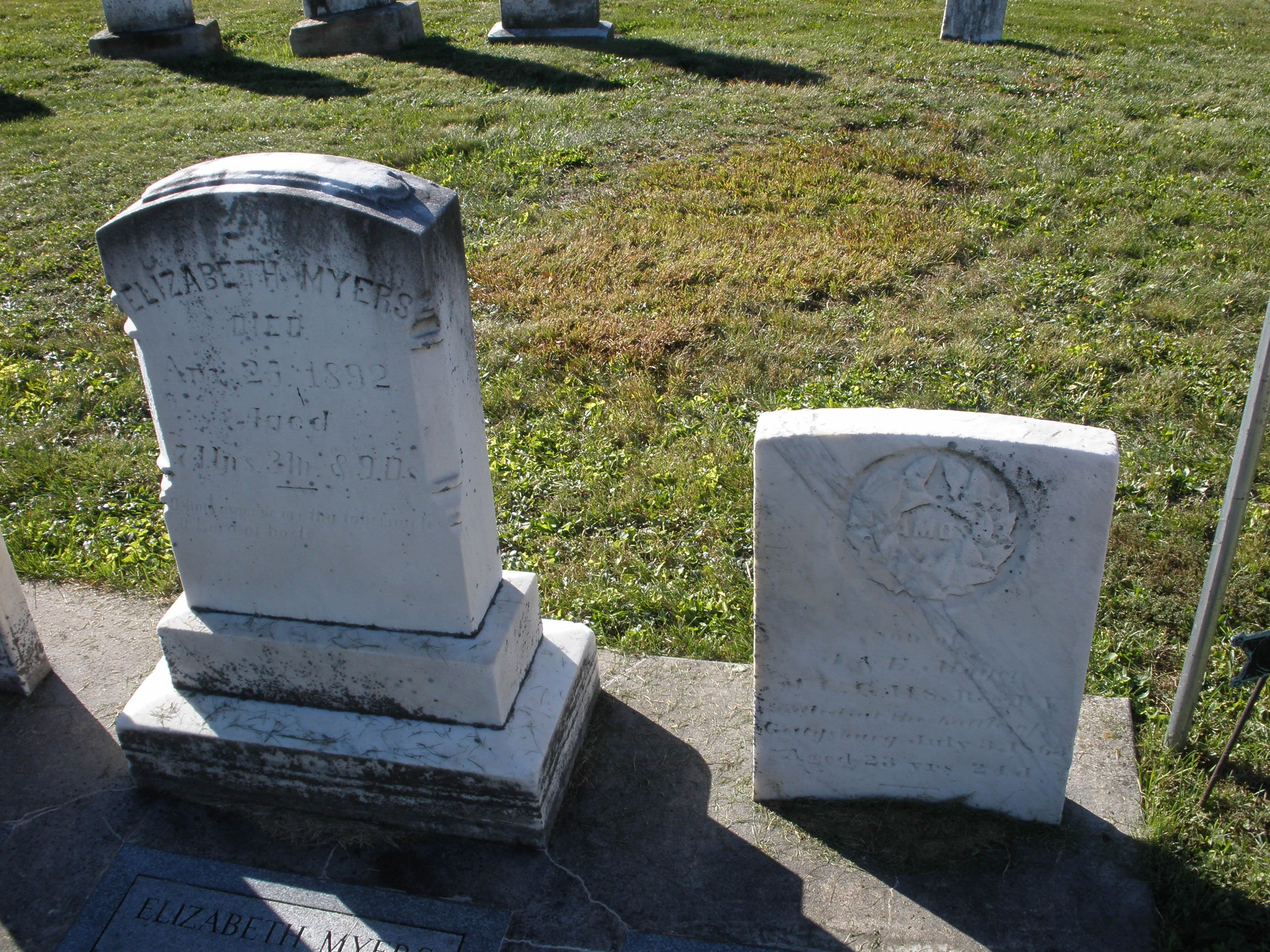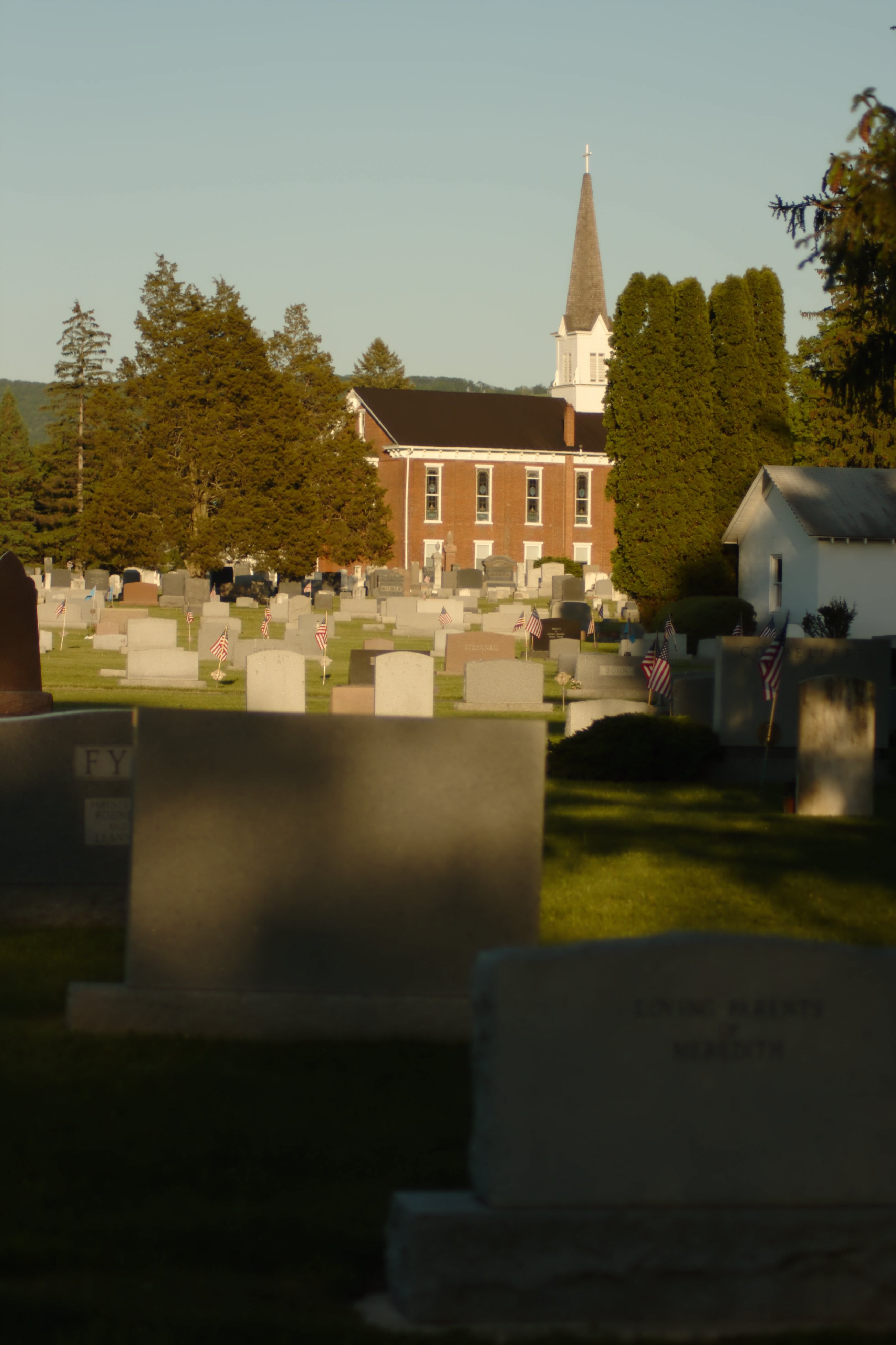
An autumn day is far from the typical backdrop of a Memorial Day celebration. If Boalsburg, Pennsylvania had anything to do with it, Memorial Day would indeed be in the autumn. Boalsburg claims to be the site of the earliest observation of Decoration Day, now known as Memorial Day. The specific date of the inaugural decorating in October of 1864, however, is unknown. Many communities make this claim, but only two have significant reasons for their claim. Boalsburg had the earliest grave decorations. Waterloo, New York, because of a 1966 Presidential order declaring it the birthplace of Memorial Day.
The men of Boalsburg, an abolitionist community in Centre County, led by Professor James Patterson, joined the Union Army in response to a call for volunteers by President Abraham Lincoln. The women of Boalsburg, with their husbands, sons and brothers at war, organized daily meetings at the Boalsburg Academy. They prepared packages and sewed and knit uniforms for their men at war. They arranged for the Boalsburg Brass Band to perform concerts to raise funds for wounded soldiers.
The men of Boalsburg suffered multiple causalities throughout the Civil War. It was the fifth casualty, the death of Dr. Reuben Hunter, on September 19, 1864, that inspired three women to visit the cemetery and decorate the graves of the fallen men. The three women, Emma Hunter, daughter of Dr. Reuben Hunter, Elizabeth Meyer, whose son Amos Meyer, was killed at the battle of Gettysburg, and Sophie Keller, decided to meet the following Sunday, share a bouquet of flowers to decorate the graves of their family members and friends.
The exact date of this event has been questioned, a gap that creates some weakness in the Boalsburg claim. October of 1864 held five Sundays: the 2nd, 9th, 16th, 23rd, and 30th. The pamphlet given out by the town of Boalsburg at the commemoration of the 85th anniversary of Memorial Day states, “Mrs. Elizabeth Meyer whose son Amos was killed at Gettysburg but likely was only recently returned for burial.” The battle of Gettysburg occurred from July 1st through the 3rd, approximately 100 miles away from Boalsburg. Taking approximately two and a half months to move Amos Meyer’s body 100 miles makes the return of Dr. Reuben Hunter’s body from Annapolis, Maryland, 175 miles away, in less than one month is somewhat suspect. The additional distance on a shortened timeline does not make the event an impossibility, however; it just raises some concerns.
After the decorating the graves of the recently fallen Boalsburg soldiers, they also decorated the graves of those men who had died in the War of 1812 and the Revolutionary War. The three women returned to the Boalsburg Academy with the intention of commemorating their fallen soldiers again on Independence Day. Before the following Independence Day, however, the women and town of Boalsburg had something new to celebrate. The Civil War had ended on April 9, 1865, and their fathers, husbands and sons were returning home from battle.
The three women of Boalsburg were the first to observe a Decoration Day, but the first community to commemorate the Nation’s fallen soldiers as a whole was Waterloo, New York. Waterloo’s Decoration Day idea is credited to Henry C. Welles, a prominent local citizen, who suggested the idea to General John D. Murray. Murray, a civil war hero, embraced the idea and garnered support of other veterans. Welles and Murray led the committee which planned Waterloo’s celebration. On May 5, 1866, the businesses of Waterloo were closed and the residents flew their flags at half-staff and decorated the graves the men who died fighting in the various different wars throughout the country’s history.

John A. Logan, Commander-In-Chief of the Grand Army of the Republic, an organization of Union Army veterans, continued to add to the importance of May 5 in the history of Memorial Day. On May 5, 1868, Logan issued an order stating, “The 30th day of May, 1868, is designated for the purpose of strewing with flowers or otherwise decorating the graves of comrades who died in defense of their country during the late rebellion…” In accordance with Logan’s order, May 30, 1868 at Arlington National Cemetery was first time where soldiers’ graves from both the Union and Confederate Armies were decorated together. Other than at Arlington, Decoration Day was mainly celebrated by Union veterans and family members of Union deceased soldiers. In fact most formerly Confederate states refused to recognize the date, and many even had their own Confederate Decoration Days. Confederate states honored their dead separately until after World War I. Nine states still to this date, honor the fallen Confederate soldiers on a separate date.
Logan’s hope for Decoration Day was “that it will be kept up from year to year, while a survivor of the war remains to honor the memory of his departed comrades.” Waterloo followed this part of the order before the order was even created; May 5, 1867 the ceremonies of the previous year were repeated for the second time. The community of Waterloo joined the rest of the country in 1868 and honored the fallen on the 30th. Boalsburg falls short on this part of its claim. The three women left the cemetery that autumn day with the intentions of returning the following July 4. However, because of a limited amount of information available on the matter it is difficult to determine whether those women or anyone from the community actually returned and decorated the graves again after the Civil War ended. This is another argument that damages Boalsburg’s claim.
Decoration Day was celebrated every year for several years before it was officially recognized by any state or the Federal government. In 1873, New York became the first state to officially recognize the holiday. All of the other Union states recognized Decoration Day by 1890. The name Memorial Day was not used until the 1880s, and was used only sparingly until after World War II. It was not changed to the official name of the holiday until Federal law changed the name in 1967. After Logan’s order, Memorial Day was celebrated every year on the 30th of May, until 1971 when Congress passed the National Holiday Act, which moved Memorial Day to its current date, the last Monday of May, to create a three day weekend.
The origin of Memorial Day is best summed up by US Memorial Day Organization:
It is more likely that it had many separate beginnings; each of those towns and every planned and spontaneous gathering of people to honor the war dead in the 1860s tapped into the general human need to honor our dead, each contributed honorably to the growing movement that culminated in Gen Logan giving his official proclamation in 1868. It is not important who was the very first, what is important is that Memorial Day was established. Memorial Day is not about division. It is about reconciliation; it is about coming together to honor those who gave their all.
However, the communities involved believe it is very important to be the very first to observe the holiday. Boalsburg is the location of the first observance; however, Waterloo is officially recognized as the birthplace of the modern version of the holiday. “On March 7, 1966, the State of New York recognized Waterloo by a proclamation signed by Governor Nelson A. Rockefeller.” Following this event, both the House of Representatives and Senate recognized Waterloo as the birth place of Memorial Day, passing House Concurrent Resolution 587 unanimously. Resolution 587 reads, “Resolved that the Congress of the United States, in recognition of the patriotic tradition set in motion one hundred years ago in the Village of Waterloo, NY, does hereby officially recognize Waterloo, New York as the birthplace of Memorial Day…” The final official recognition came in the form of a Presidential Proclamation, signed by President Lyndon B. Johnson on May 26, 1966.
Both communities have strong arguments supporting their claims and both are deserving of recognition. Waterloo is recognized because of being the first to as a community honor the fallen soldiers on May 5, 1866. Boalsburg is the location of the first observation by the three women, Emma Hunter, Elizabeth Meyer, and Sophie Keller, in October of 1864. If Boalsburg had more information supporting their claim and proof of a continued tradition in 1865-1868 there would be no doubt whatsoever of the fact that they were the first to observe Memorial Day.
Sources:
- Bechdel, Leanne K. Dr Reuben Hunter ( - 1864) - Find A Grave Memorial. N.p., 4 July 2008. 11 Oct. 2010. <http://www.findagrave.com/cgi-bin/fg.cgi?page=gr&GRid=12807002>.
- Boalsburg. Ed. Christopher Lee. Boalsburg, PA, 2010.
- Boalsburg Fire Company. 85th Anniversary of Memorial Day, 1864-1949. Boalsburg, PA, PA: n.p., 1949.
- Calendar 1864. 11 Oct. 2010 <http://www.hf.rim.or.jp/~kaji/cal/cal.cgi?1864>.
- Fahs, Alice, and Joan Waugh. The Memory of the Civil War in American Culture. Chapel Hill: University of North Carolina Press, 2004.
- Gettysburg Battle American Civil War July 1863. N.p., n.d. Web. 11 Oct. 2010. <http://americancivilwar.com/getty.html>.
- Harmond, Richard P., and Thomas J. Curran. A History of Memorial Day: Unity, Discord, and the Pursuit of Happiness. New York: P. Lang, 2002.
- “History of Memorial Day.” The History Channel website. 11 Oct. 2010 <http://www.history.com/topics/memorial-day-history>.
- Knight, Glenn B. SUVCW--Grand Army of the Republic. Grand Army of the Republic, n.d. 11 Oct. 2010. <http://www.suvcw.org/gar.htm>.
- Logan, John A. Logan Memorial. John A. Logan College, n.d. 11 Oct. 2010 <http://web.archive.org/web/20070315014031/http://www.jal.cc.il.us/loganm....
- Memorial Day. N.p., 2007. 11 Oct. 2010 <http://www.familyfunshop.com/memorialday.htm>.
- Memorial Day History. US Memorial Day Organization, 4 Apr. 2009. 11 Oct. 2010 <http://www.usmemorialday.org/backgrnd.html>.
- Memorial Day History. Office of Public and Intergovernmental Affairs, 10 Nov. 2009. 11 Oct. 2010 <http://www1.va.gov/opa/speceven/memday/history.asp>.
- Memorial Day History. Waterloo, NY, n.d. 11 Oct. 2010 <http://www.waterloony.com/MemDay.html>.
- Stathis, Stephen W. “Federal Holidays.” US Senate, 8 Feb. 1999. 11 Oct. 2010 <http://www.senate.gov/reference/resources/pdf/Federal_Holidays.pdf>.
- “U.S. Civil War 1861-1865.” The History Place. 1996. 11 Oct. 2010 <http://www.historyplace.com/civilwar/>.


